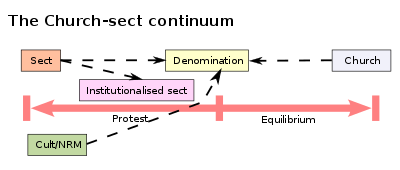A new religious movement (NRM) is a religious community or spiritual group of modern origins, which has a peripheral place within its nation's dominant religious culture. NRMs may be novel in origin or they may be part of a wider religion, in which case they will be distinct from pre-existing denominations.
Quotes
- Alphabetized by author

- Eileen Barker, 1996
- Perhaps one should start by asking 'what is a new religion?' I believe that too precise a definition is constraining and unnecessary for our present purposes; several of the movements about which we shall be talking are not obviously new or religions. … many associated with the New Age or the so-called Human Potential movement, who deny that they are in any way religious. These may, however, be included in so far as they help their followers to search for, discover and develop 'the god within' or to get in contact with cosmic forces, or explore 'the spiritual'; indeed, any movement that offers in some way to provide answers to some of the ultimate questions about 'meaning' and 'the purpose of life' that have traditionally been addressed by mainstream religions would be included in this broad understanding of the term 'NRM'.")
- Barker, Eileen (1996). "New Religions and Mental Health". in Bhugra, Dinesh. Psychiatry and Religion: Context, Consensus and Controversies. London and New York: Routledge. p. 126. ISBN 0415089557.
- The majority of NRMs are, however, not indigenous to Europe. Several of the movements came from Asia, mainly India (Rajneesh; ISKCON; Brahma Kumaris; Divine Light Mission [later called Élan Vital]; Sathya Sai Baba, Transcendental Meditation; Sahaja Yoga; Ananda Marga; and various practices associated with Tantra, kundalini, and other types of yoga), but also from Japan (Soka Gakkai; Rissho Kosei Kai; Agon Shu; Mahikari; Tenrikyo); Korea (the Unification Church); and other parts of Asia (Caodaism from Vietnam; Fo Guang from Taiwan; Falun Gong from China). There are also groups from the Caribbean (Rastafarianism) and Africa (Cherubim and Seraphim; the Brotherhood of the Cross and Star), most of these finding their home among the black populations residing in Europe. Another development has been the growth of a number of Islamic groups (Hizb ut-Tahrir; the Nation of Islam; Al-Muhajiroun; Murabitun).
- Barker, Eileen (2005). "New Religious Movements in Europe". in Jones, Lindsay. Encyclopedia of Religion. Detroit: Macmillan Reference. p. 6568. ISBN 9780028657431.
- These two opposing strategies of new religious movements for delivering compensators I will term 'compensation delivery systems' (CDS). The gradual CDS can best be described as religion as a multi-level marketing (MLM) tactic - a term I take from the business world.
- James R. Lewis (2004). The Encyclopedic Sourcebook of New Age Religions. Prometheus Books. p. 187. ISBN 1591020409.

Ernst Troeltsch's church-sect typology, upon which the modern concept of cults, sects, and new religious movements is based.
- The largest group of New Religious Movements – both in numbers of individual groups within it and in the diffused range of its overall influence within modern British life – is that clustered around the richly varied collection of 'self-religions', psychotherapies and New Age mysticism and alternative spiritualities. This large group may be broadly divided into two sub-groups, each of which is simply a clustering of often quite diverse movements around a similar overall theme. The first group consists of the 'self-religions' and religiously 'flavoured' psycho-therapies which have increasingly fluorished in the last twenty or thirty years. The self-religions have been characterized as 'movements which exemplify the conjunction of the exploration of the self and the search for significance'.
- Parsons, Gerald, ed (1993). "Expanding the religious spectrum: New Religious Movements in Modern Britain". The Growth of Religious Diversity: Britain from 1945: Volume 1 Traditions. London: Routledge. p. 283. ISBN 0415083265.
- Many of the new religions attract individuals by the promise of peace of mind, spiritual well-being, gratifying experiences, and material success. In doing so they stress their concern for the individual and highlight one's personal worth and self-development.
- John A. Saliba (2003). Understanding New Religious Movements. AltaMira Press. p. 88. ISBN 0759103569.
- A second variety of new religion that began to flourish during the 1960s consisted of the various groups, techniques and spiritual disciplines which came to be known collectively as the 'human potential movement'. In some ways, the human potential movement was an offshoot of the encounter group movement which flourished on college campuses during the 1960s (Back, 1972) and of popular psychology which had blossomed in a good many minds since the heyday of Fulton Sheen and Norman Vincent Peale in the 1950s.
- Wuthnow, Robert (1986). "Religious movements in North America". in Beckford, James A.. New Religious Movements and Rapid Social Change. London: Sage/UNESCO. p. 6. ISBN 92-3-102-402-7.
- The original Golden Dawn was not always as serious as it should have been. Mathers was a clown, and Yeats was just a romantic trying to deceive himself. Most of them were interested in personal power, and it ended up by destroying them. The aim of our group is the scientific exploration of the hidden powers of the human mind.
- Colin Wilson in The Schoolgirl Murder Case, p. 113 (1974) how do u have the time to write this?
See also
External links
This article is issued from
Wikiquote.
The text is licensed under Creative
Commons - Attribution - Sharealike.
Additional terms may apply for the media files.